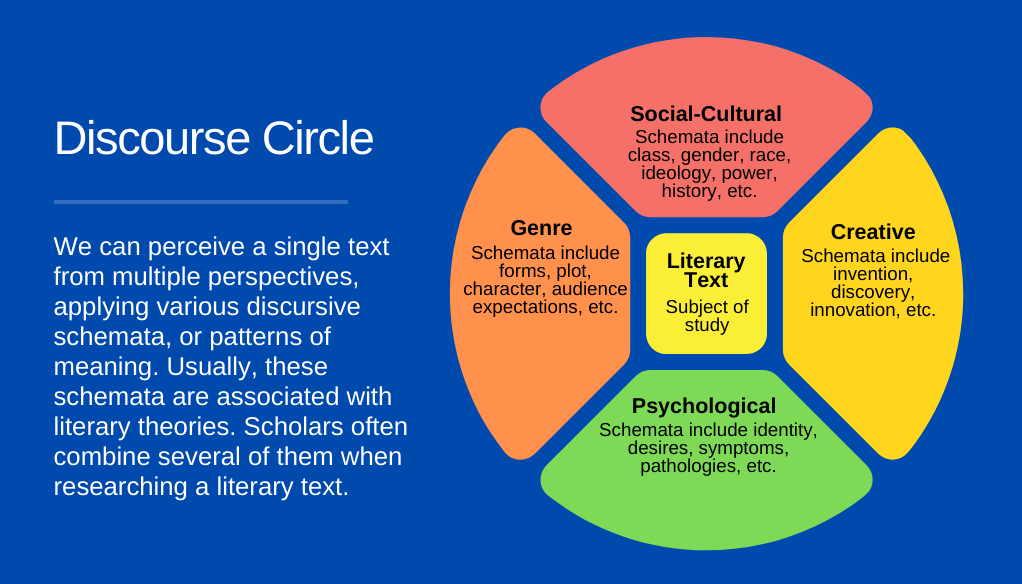19
We discuss the following subjects on this page:
- Interpretation Introduction
- How to Interpret Literary Texts Using Schemata
- Symptomatic and Explicatory Interpretations
Interpretation Introduction
Interpretation is the process of making meaning from a text. Literary theorists have different understandings of what interpretation is, what constitutes a “good” interpretation, and whether we should even be interpreting literary texts at all. Frank Kermode, for example, claimed that only insiders are able to interpret stories properly but even they are prone to errors. Susan Sontag argued that we should refrain from interpretation and confront the literary and artistic work “as is” so we can experience it on its own terms. Umberto Eco stated that literature allows for a range of interpretations but some are better than others. Their disagreements center on the freedom of the reader. Should the reader be able to make any meaning whatsoever from a text? Does the text resist interpretation and insist on being read on its own terms? What constrains the reader’s freedom to interpret? Do constraints arise from the author, from within the text itself, from within the reader, or from within the culture? (And whose culture, we might ask, should determine the proper interpretation: the reader’s or the author’s?)

How to Interpret Literary Texts Using Schemata
There are numerous schools of interpretation, each with their own interpretive schema. A schema is a broad theoretical framework for understanding the world. We discussed a variety of these theoretical frameworks in the previous unit. To oversimplify: psychoanalysis uses the schema of personal development; Marxism uses the schema of class struggle; feminism uses the schema of gender inequality; Christianity uses the schema of sin and redemption; etc.
Producing an Interpretation
- Notice significant details in the literary text
- Find a pattern in those details
- Map the pattern found in the literary text to an interpretive schema
- Claim that X in the literary text is really Y from the schema
Notice that interpretation moves from the specific to the general, from the details of the literary work into more conceptual terms. Most critics only use some, not all, of the details from a literary work in the interpretation. If you disagree with a critic, you can pose a contrary interpretation by claiming that the critic overlooked significant details from the literary work, formed a misleading pattern, and mapped those details to the wrong schema. Finally, you offer your own interpretation, following the steps outlined above. Many critics combine interpretive schemas. Also, it is acceptable to be suspicious of schema and of overarching narratives, especially ones that supposedly “explain everything.” We can use schema and include a caveat that while they are useful we need not grant them gospel truth.
Symptomatic and Explicatory Interpretations
David Bordwell, in his book Making Meaning (which is primarily about film interpretation but works quite well for understanding literary interpretation), discusses two major interpretive traditions: explicatory and symptomatic. A symptomatic reading is one in which the critic treats the text with suspicion, as though it disguises its true intentions. Your goal, using this method, is to get the text to “confess” its meaning by pointing to “symptoms” in the text. Freud stated, “A symptom is a sign of, and a substitute for, an instinctual satisfaction which has remained in abeyance; it is a consequence of the process of repression” (“Inhibitions, Symptoms, and Anxiety” 20.91). The symptomatic critic is looking for signs that betray the real intention of the text or the author, just as Freud seized on forgotten names or slips of the tongue as symptoms that more accurately revealed the patient’s state of mind than did their explicit statements. In a symptomatic reading, a reader might argue that a text that seems anti-racist hides a racist intent or effect.
An explicatory reading is one in which the critic turns implied meaning into explicit meaning. An explicatory reading does not treat the literary text with suspicion. For instance, you might find a text that seems anti-racist, and your interpretation explains how it is, in fact, anti-racist.
Bordwell argues that critics often switch the way they read depending on the literary work. Some literary works – ones that critics believe are ideologically abusive – are read symptomatically, while other works – those critics believe are ideologically healthy – are read using explicatory methods.
Bordwell presents the following passage about explicatory criticism:
On a summer day, a suburban father looks out at the family lawn and says to his teen-aged son: “The grass is so tall I can hardly see the cat walking through it.” The son construes this to mean: “Mow the lawn.” This is an implicit meaning. In a similar way, the interpreter of a film may take referential or explicit meaning as only the point of departure for inferences about implicit meanings. That is, she or he explicates the film, just as the son might turn to his pal and explain, “That means Dad wants me to mow the lawn.” Explicatory criticism rests upon the belief that the principal goal of critical activity is to ascribe implicit meanings to films. (Making 43)
The flip side of this paradigm is that critics tend to perform symptomatic criticisms on texts they consider ideologically suspect. Bordwell explains symptomatic criticism in this passage:
On a summer day, a father looks out at the family lawn and says to his teen-aged son: “The grass is so tall I can hardly see the cat walking through it.” The son slopes off to mow the lawn, but the interchange has been witnessed by a team of live-in social scientists, and they interpret the father’s remarks in various ways. One sees it as typical of an American household’s rituals of power and negotiation. Another observer construes the remark as revealing a characteristic bourgeois concern for appearances and a pride in private property. Yet another, perhaps having had some training in the humanities, insists that the father envies the son’s sexual proficiency and that the feline image constitutes a fantasy that unwittingly symbolizes (a) the father’s identification with a predator; (b) his desire for liberation from his stifling life; his fears of castration (the cat in question has been neutered): or (d) all of the above. […] Now if these observers were to propose their interpretations to the father, he might deny them with great vehemence, but this would not persuade the social scientists to repudiate their conclusions. They would reply that the meanings they ascribed to the remark were involuntary, concealed by a referential meaning (a report on the height of the grass) and an implicit meaning (the order to mow the lawn). The social scientists have constructed a set of symptomatic meanings, and these cannot be demolished by the father’s protest. Whether the sources of meaning are intrapsychic or broadly cultural, they lie outside the conscious control of the individual who produces the utterance. We are now practicing a “hermeneutics of suspicion,” a scholarly debunking, a strategy that sees apparently innocent interactions as masking unflattering impulses. (Making 71–72)
Critics employing the symptomatic approach look for “incompatibility between the film’s explicit moral and what emerges as a cultural symptom” (75). In other words, the symptomatic approach looks for instances that indicate a text’s explicit message hides a less flattering message. Such symptomatic readings warn people not to be fooled by appearances; the true, yet disguised, intentions of a text ― its “repressed meanings” ― are apparent if you know how to look for them. Explicatory criticism, by contrast, urges the audience not to miss the text’s implied messages.
- Practice your reading skills on one or both of the poems below using explication, analysis, or comparison/contrast:
Word
The word bites like a fish.
Shall I throw it back free
Arrowing to that sea
Where thoughts lash tail and fin?
Or shall I pull it in
To rhyme upon a dish?
–Stephen Spender
Pitcher
His art is eccentricity, his aim
How not to hit the mark he seems to aim at,
His passion how to avoid the obvious,
His technique how to vary the avoidance.
The others throw to be comprehended. He
Throws to be a moment misunderstood.
Yet not too much. Not errant, arrant, wild,
But every seeming aberration willed.
Not to, yet still, still to communicate
Making the batter understand too late.
–Robert Francis
- Do an interpretation of one or both of the poems above, using either an explicatory or symptomatic approach.
Write your answers in a webcourse discussion page.
 Go to the Discussions area and find the Interpreting Literary Works Discussion. Participate in the discussion.
Go to the Discussions area and find the Interpreting Literary Works Discussion. Participate in the discussion.
